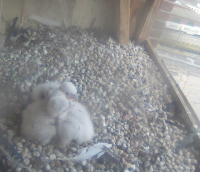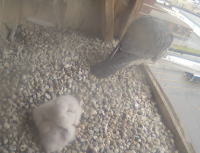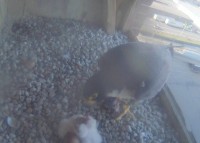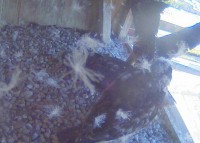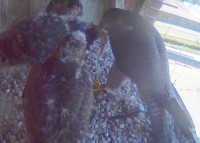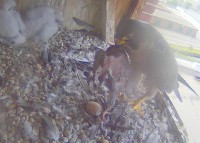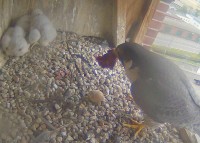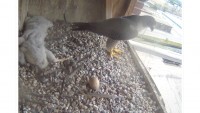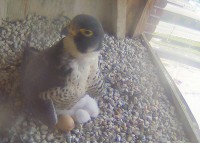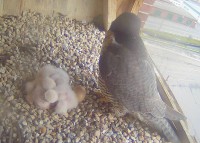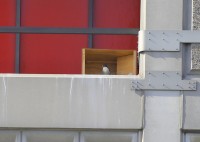Lawrence Peregrines: Day 12
May 16, 2019 in In the Nest Box, lawrence peregrines
The peregrines started this morning off under mostly sunny skies, little wind, and temp at 44F. The forecast calls for isolated showers after noon. Mostly cloudy, with a high near 67. Calm wind becoming northwest around 5 mph in the afternoon. Tonight, patchy fog after 3am. Otherwise, mostly cloudy, with a low around 48. Light and variable wind.
 This morning the chicks were first seen int he next box by themselves with the female nearby on the perch pole. By 5:40 AM she was back in the nest box preening and scratching herself aside the chicks. Just after that, she settled on the outer edge of the nest box looking out to the west, and the chicks remained in tight huddle formation with the the addled egg still close by. Overall, the little ones are moving around more, wing stretching and being playful with each other. They are literally a tight bunch at this age!
This morning the chicks were first seen int he next box by themselves with the female nearby on the perch pole. By 5:40 AM she was back in the nest box preening and scratching herself aside the chicks. Just after that, she settled on the outer edge of the nest box looking out to the west, and the chicks remained in tight huddle formation with the the addled egg still close by. Overall, the little ones are moving around more, wing stretching and being playful with each other. They are literally a tight bunch at this age!
As was mentioned in a prior post, the adults will shelter the nestlings from strong sunshine, and rain, as may be needed, when they are too large to brood but not yet protected by their own feathers.
Literature cited: Ratcliffe, D. 1993. The Peregrine Falcon. 2nd ed. Carlton, England: T. and A. D. Poyser.
